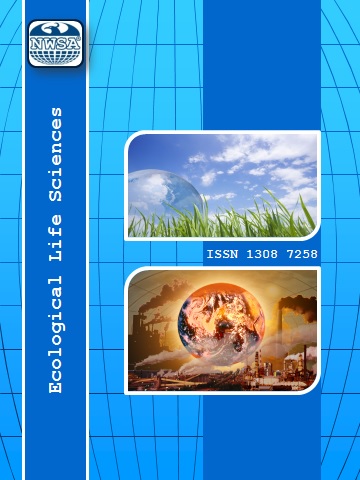References
[1] Golani, D., Ozturk, B., and Ba?usta, N., (2006). Fishes of the eastern Mediterranean. Turkish Marine Research Foundation, Istanbul, Turkey. Pub. Number: 24, pp. 259.
[2] Tous, P., Sidibé, A, Mbye, E., de Morais, L., Camara, Y.H., Adeofe, T.A., Monroe, T., Camara, K., Cissoko, K., Djiman, R., Sagna, A., Sylla, M., and Carpenter, K.E., (2015).
[3] Engraulis encrasicolus. The IUCN Red List of Threatened Species 2015: e. T198568A15546291. http://dx.doi.org/10.2305/IUCN.UK.2015- 4.RLTS.T198568A15546291.en. Downloaded on 17 August 2019.
[4] Ba?usta, A. ve Da? Byyykly, N., (2022). Kuzeydo?u Akdenizde ya?ayan chelidonichthys lucerna (linnaeus, 1758) türünün otolit biyometrisi. Ecological Life Sciences, 17(4):187-202. https://doi.org/10.12739/NWSA.2022.17.4.5A0178.
[5] Basusta, A., Ozer, E.I. ve Girgin, H., (2013b). Akdenizdeki Lepidotrigla dieuzeidei (Blanc & Hureau, 1973) popülasyonunda otolit biyometrisi-balyk uzunlu?u arasyndaki ili?ki. Yunus Ara?tyrma Bülteni, 3:3-9.
[6] Ba?usta, A. and Ba?usta, N., (2018). Otolith dimensions-fish length relationships of Mediterranean slimehead (Hoplostethus mediterraneus)caught from Northeastern Mediterranean, Turkey. International Marine and Freshwater Sciences Symposium, 18-21 October, Kemer Antalya, Proceeding Book p:295-299.
[7] Ba?usta, A., Çetinkaya, B., and Ba?usta, N., (2020). The relationships between fish size and otolith dimensions in the common sole (Solea solea (Linnaeus, 1758)) captured in the Northeastern Mediterranean. Journal of Applied Ichthyology, 36(6):888-892.
[8] Ba?usta, A., Co?kun, Y. ve Ba?usta, N., (2024). Yskenderun Körfezinde ya?ayan Argentina sphyraena (Linnaeus, 1758) türünün otolit biyometrisi. Ecological Life Sciences, 19(1):7-15, DOI: 10.12739/NWSA.2024.19.1.5A0206.
[9] Ba?usta, N. ve Tan, M., (2019). Kuzeydo?u Akdenizden Yakalanan Tiryaki Baly?ynyn (Uranoscopus scaber L., 1758) Otolit Boyutlary-Balyk Büyüklü?ü Yli?kileri. Ecological Life Sciences, 14(4):110-118.
[10] Canda?, M. ve Ba?usta, N., (2023). Kuzeydo?u Akdenizde Ya?ayan Sarya?yz (Argyrosomus regius) Baly?ynyn Otolit Biyometrisi. Ecological Life Sciences, 18(3):101-107. DOI: 10.12739/NWSA.2023.18.3.5A0196.
[11] Dilgin, I. ve Ba?usta, N., (2023). Yskenderun Körfezinde ya?ayan yskarmoz (saurida lessepsianus) baly?ynyn otolit biyometrisi. Ecological Life Sciences, 18(3):78-83, DOI: 10.12739/NWSA.2023.18.3.5A0193.
[12] Girgin, H. ve Ba?usta, A., (2022). Kuzeydo?u Akdenizde ya?ayan yalancy ysparoz (Pomadasys stridens (Forsskal, 1775) türünün otolit biyometrisi. Ecological Life Sciences, 17(4):245-256. https://doi.org/10.12739/NWSA.2022.17.4.5A0185.
[13] Girgin, H., and Ba?usta, N., (2023). The relationships of otolith dimensions (Length-Breadth) with weight and total length of greater forkbeard (Phycis blennoides (Brünnich, 1768)) captured from northeastern Mediterranean Sea. Natural and Engineering Sciences, 8(3):151-158. https://doi.org/10.28978/nesciences.1404910.
[14] Karachle, P., Ba?usta, A., Ba?usta, N., Bostancy, D., Buz, K., Girgin, H., Chater, I., Kokokiris, L., Konta?, S., Ktari, M.H., Maravelias, C., Minos, G., Ozer, E., Romdhani, A., Tiralongo, F., Tibullo, D., Tserpes, G., and Vasilakopoulos, P., (2015). New Fisheries-related data from the Mediterranean Sea (April 2015). Mediterranean Marine Science, 16(1):285293. https://doi.org/10.12681/mms.1293.
[15] Karahan, A., Borsa, P., Gücü, A.C., Kandemir, Y., Özkan, E., Ak Örek, Y., Can Acan, S., Koban, E., and Togan, I., (2014). Geometric morphometrics, Fourier analysis of otolith shape, and nuclear-DNA markers distinguish two anchovy species (Engraulis spp.) in the Eastern Mediterranean Sea. Fisheries Research. 159:45-55.
[16] Turan, C., Ergüden, D., Gürlek, M., Ba?usta, N., and Turan, F., (2004). Morphometric Structuring of the Anchovy (Engraulis encrasicolus L.) in the Black, Aegean and Northeastern Mediterranean Seas. Turkish Journal of Veterinary & Animal Sciences, 28(5):865-871.
[17] Ba?çynar, N.S. and Atylgan, E., (2016). Otolith Morphometry and Shape Analysis of Anchovy (Engraulis encrasicolus, L. 1758) living in Different Regions Black Sea: Ukraine and Türkiye (Rize, Samsun). Aquaculture Studies, 16(4):311-320. https://doi.org/10.17693/yunusae.v16i26717.281030.
[18] Çelikkale M.S., (1991). Balyk Biyolojisi. Karadeniz Teknik Üniversitesi Sürmene Deniz Bilimleri ve Teknolojisi Yüksek Okulu. Genel Yayyn No: 101 Fakülte Yayyn No:1, Trabzon, 387 s.
[19] Fowler, J., and Cohen, L., (1992). Practical statistics for Field Biology. John Wiley and Sons Inc, New York, 227p.
 +90(535) 849 84 68
+90(535) 849 84 68 nwsa.akademi@hotmail.com
nwsa.akademi@hotmail.com Fırat Akademi Samsun-Türkiye
Fırat Akademi Samsun-Türkiye
